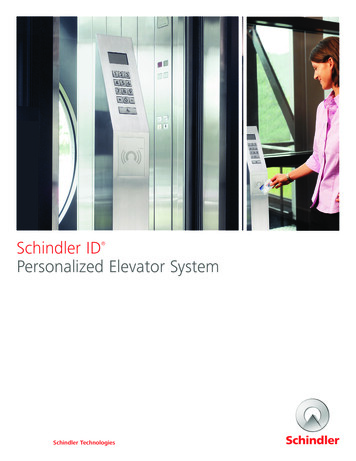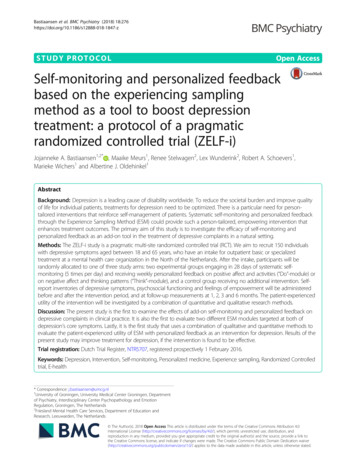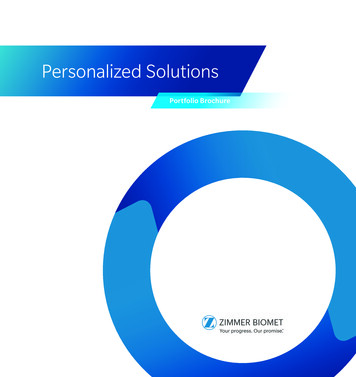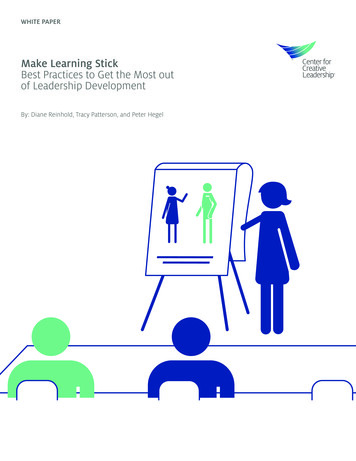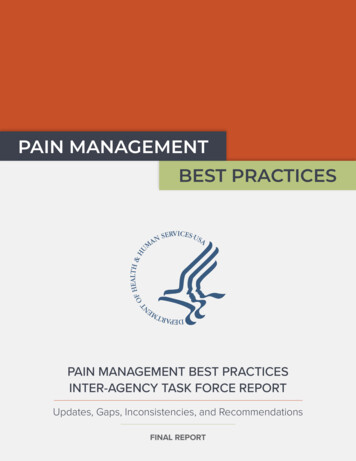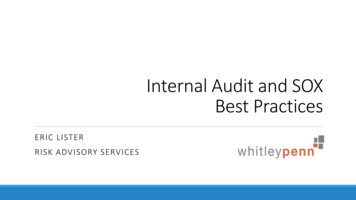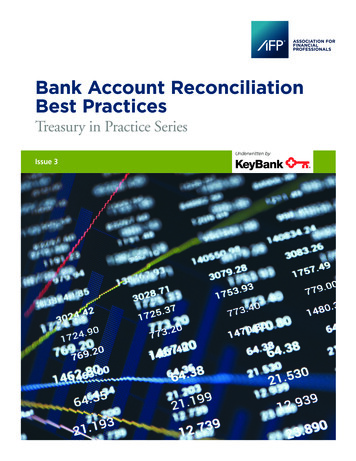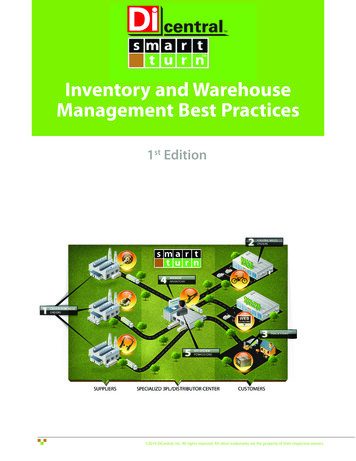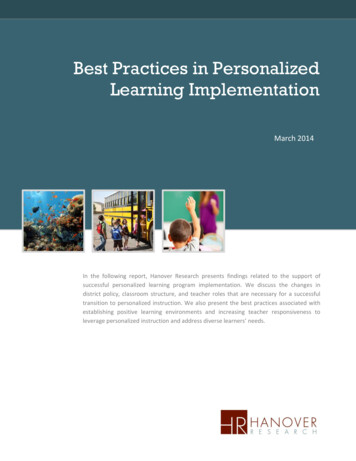
Transcription
Best Practices in PersonalizedLearning ImplementationMarch 2014In the following report, Hanover Research presents findings related to the support ofsuccessful personalized learning program implementation. We discuss the changes indistrict policy, classroom structure, and teacher roles that are necessary for a successfultransition to personalized instruction. We also present the best practices associated withestablishing positive learning environments and increasing teacher responsiveness toleverage personalized instruction and address diverse learners’ needs.
Hanover Research March 2014TABLE OF CONTENTSExecutive Summary and Key Findings . 4INTRODUCTION .4KEY FINDINGS .4Section I: Staffing and Professional Development . 6DEFINITION .6Elements of Personalized Learning .7Learning Environments .8ROLE OF TEACHERS .9Teacher Skills .9Teacher Buy-In .11ROLE OF SCHOOL ADMINISTRATORS .11ROLE OF EMPLOYERS .11Re-examining Traditional Hiring Practices .12PROFESSIONAL DEVELOPMENT .13Professional Learning Communities .14Section II: District and Classroom Program Implementation . 15COMMON IMPLEMENTATION CHALLENGES .15POLICY-LEVEL IMPLEMENTATION .16CLASSROOM-LEVEL IMPLEMENTATION .17Assessment & Data .17Curricula .18Technology.18INFRASTRUCTURE REQUIREMENTS.19Broadband .19Digital Devices.20PROFILE: MOORESVILLE GRADED SCHOOL DISTRICT, NC .21Section III: Personalized Learning for Diverse Learners . 24OPTIMIZING PERSONALIZED INSTRUCTION .24Positive Learning Environment .24Responsive Teachers.25PROFILE: THE METROPOLITAN REGIONAL CAREER AND TECHNICAL CENTER, PROVIDENCE, RI .27 2013 Hanover Research District Administration Practice2
Hanover Research March 2014Personalized Learning Goals .28Authentic Learning.29Flexible Assessment .29At-Risk Learners .30Success .30Conclusion . 31 2013 Hanover Research District Administration Practice3
Hanover Research March 2014EXECUTIVE S UMMARY AND KEY FINDINGSINTRODUCTIONThis report discusses the best practices in system-wide personalized learning programimplementation. It focuses on various facets that support systemic change towardpersonalized learning, including district-level policy changes, the roles of teachers andadministrators, and strategies for effective professional development practices. We alsoaddress how best to leverage personalized instruction to meet the needs of diverselearners, focusing on the creation of positive learning environments and increasingteachers’ responsiveness to diverse student populations.This report comprises the following sections: Section I: Staffing and Professional Development defines personalized instruction,outlines the re-defined role of the teacher, and describes how to emphasizepersonalized learning in hiring practices. This section also discusses how to obtainteacher buy-in for personalized instruction initiatives, and provides suggestions onprofessional development opportunities that support personalized instruction. Section II: District and Classroom Program Implementation describes the commonchallenges associated with transitions to personalized learning programs, and outlinesstrategies for their successful implementation at the district level and the classroomlevel. This section includes a profile of an exemplary model in personalized learningimplementation, Mooresville Graded School District in North Carolina. Section III: Personalized Learning for Diverse Leaners discusses how to leveragepositive learning environments and increased teacher responsiveness to optimizeinstruction for diverse sets of learners. This section includes a profile of a schoolnetwork that has successfully implemented personalized learning for diverse learners,the Metropolitan Regional Career and Technical Center in Rhode Island. ConclusionKEY FINDINGS Rather than a set of prescribed best practices, personalized learning can be thoughtof as a holistic, student-centered approach to instruction. Personalized learning ischaracterized by the promotion of 21st century skills and the use of technology tocreate instructional pathways that incorporate students’ needs, interests, andaspirations. The best personalized learning programs are situated within a strongcommunity of teachers, parents, and students. Technology affords teachers the flexibility to spend more time personalizinginstruction for individual students. Without appropriate technological infrastructure,personalized learning cannot be brought to scale for more than a few students at a 2013 Hanover Research District Administration Practice4
Hanover Research March 2014time. Though personalized learning and technology are intimately linked, sound policyand good instruction must precede the blind adoption of new technologies. Successfully implementing personalized learning requires change on two levels: thedistrict policy level and the classroom level. Changes on the district level requiresystem-wide alterations to programs, processes, and personnel. At the classroomlevel, curricula, assessments, student data, and technology should be seamlesslyincorporated to create personalized learning trajectories for each student. The most effective teachers in personalized instruction programs understand that allstudents can learn, have high expectations of their students, and take on the role of“instructional facilitator.” Often, teachers’ experiences and education do not alignwith the expectations of the “facilitator” role, so existing teachers should be givenample professional development opportunities to supplement their current skills.Hiring managers should screen candidates, conduct behavioral interviews, and consultcandidates’ references to ensure that new hires possess the qualities that mostdirectly align with the district’s personalized instruction priorities. Principals’ rolesmust also change, and those principals who voice and provide support forpersonalized instruction initiatives witness the most success. Transitioning to personalized instruction requires significant deviation from thestructures and processes associated with traditional methods of instruction. Forinstance, due to the emphasis on students’ competencies and mastery of skills ratherthan seat time, personalized learning programs benefit from flexibility in the amountof time students have to master concepts. Districts and schools should also considermaking scheduling accommodations for teacher training in personalized instruction,the increased use of computer labs, and spaces for frequent small-group activities. Personalized instruction is an effective way to meet the needs of diverse learners, asits fundamental aim is to optimize learning for all students, including diverse and atrisk students. Positive, personalized learning environments serve to augmentstudents’ feelings of belonging, which in turn increases motivation and the desire toremain in school. Teachers can use several strategies, such as communicating highexpectations and engaging students in active learning, to further customize instructionfor diverse learners. 2013 Hanover Research District Administration Practice5
Hanover Research March 2014SECTION I: STAFFINGDEVELOPMENTANDP ROFESSIONALIn the following section, Hanover Research discusses the systematic changes related to staffdevelopment necessary for the successful implementation of personalized learningprograms. First, to provide context to the discussion of implementation, we definepersonalized instruction and discuss the key components of personalized learning programs.Next, we examine changes to teacher and administrator roles, and provide guidelines forhiring the best personalized instruction teachers. Finally, we conclude by discussing thetypes of professional development opportunities that the most successful personalizedlearning programs provide for their staff members.DEFINITIONBroadly, personalized learning refers to a student-centered, student-directed approach toinstruction. Though personalized learning has existed since the 1970s,1 the newest brand ofpersonalized learning emphasizes teaching and learning 21st century skills. Personalizedlearning aims primarily to support students’ needs and interests. Rather than teachingstudents in a “one-size-fits-all, factory assembly-line classroom-based model developedover a century ago,”2 this instructional model gives students a unique learning experiencebased upon their individual needs. Personalized learning puts the needs of students first,and students are able to direct “how, what, when, and where” they learn.3Personalized learning is also intimately connected with utilizing advances in technology.Personalizing instruction for every student can be challenging, but technology provideseducators with the flexibility to adapt to learners’ needs quickly. Technology also providesstudents real-time access to custom content and resources, thereby encouraging studentsto take ownership of their learning.4 Furthermore, many programs offer assistance withtasks such as assessment and grading, which allows teachers to spend more time withindividual students. Technology thus allows for the individualization of engaging, effectivelearning experiences that are appropriately paced and tailored to fit with each student’sprior experience and interests.5The U.S. Department of Education distinguishes between individualization, differentiation,and personalization of instruction, since some educators use the terms interchangeably.Personalized instruction encompasses aspects of both differentiated instruction, which1Jenkins, J. M., and Keefe, J. M. “Two Schools: Two Approaches to Personalized Learning.” Phi Delta Kappan, 83:6,2002, pp. 449-456. mas%20Haney.doc2“About Personalized Learning.” The APLUS . Ibid.4Culatta, R. “Personalizing Learning.” U.S. Department of Education. July 10, Learning: Engage and Empower.” U.S. Department of Education. age-and-empower 2013 Hanover Research District Administration Practice6
Hanover Research March 2014refers to adjusting the learning approach, and individualized instruction, which refers toadjusting the pace of learning. In this report, the definition of personalized instructionpresented in the table below will be used unless otherwise specified. Figure 1.1 illustratesthe distinguishing features of individualized, differentiated, and personalized instruction.Figure 1.1: Individualized, Differentiated, and Personalized LIZATION Instruction is paced to the Instruction is paced to learninglearning needs of differentneeds, tailored to learning Instruction is tailored to thelearners.preferences, and tailored to thelearning preferences of Learning goals are the same forspecific interests of differentdifferent learners.all students, but studentslearners. Learning goals are the sameprogress through material at In a fully-personalizedfor all students, but thedifferent speeds according toenvironment, the learningmethod or approach oftheir learning needs.objectives and content as wellinstruction varies according to Students may take longer toas the method and pace may allthe preferences of eachprogress through a given topic,vary.student or what research hasskip topics that coverfound works best for students Thus, personalizationinformation they already know,like them.encompasses differentiationor repeat topics they need moreand individualization.help on.Source: U.S. Department of Education6ELEMENTS OF PERSONALIZED LEARNINGAs mentioned above, personalized learning can refer to numerous aspects of studentcentered instruction. However, there are certain features that are shared among mostpersonalized instruction programs. A 2012 presentation by Richard Culatta, Deputy Directorof the U.S. Department of Education (ED)’s Office of Educational Technology, enumeratesthe following “essential elements” of personalized learning: students have access to theirown devices; near real-time feedback is given to parents, students, and teachers; programsallow students to “own” their data; and educators leverage patterns in students’ data.Rather than rely on outdated computer labs, it is recommended that districts work towardproviding each student with individual access to learning devices. Additionally, to maximizethe effectiveness of more frequent assessments, real-time feedback should be generatedand shared among students, teachers, and parents. This helps to create a community thatfocuses on learning. Students should also be encouraged to take ownership of these data,which helps them develop autonomy by increasing their self-awareness and responsibilityover their strengths, weaknesses, achievements, and opportunities for improvement.Finally, patterns derived from student interactions with digital learning resources should beused to further customize instruction.767Table items adapted from: Ibid.Culatta, R. “Personalizing Learning.” U.S. Department of Education. July 10, 2012.http://www.ed.gov/teaching/summerseminars 2013 Hanover Research District Administration Practice7
Hanover Research March 2014The Association of Personalized Learning Schools and Services (APLUS ), a membershiporganization consisting of over 40 personalized learning charter schools in California, addsthat personalized learning can be characterized by: 8 Putting the needs of students firstTailoring learning plans to individual studentsSupporting students in reaching their potentialProviding flexibility in how, what, when, and where students learnSupporting parent involvement in student learningEncouraging relationships between student, parent, teacher, school, and communityPreparing students to be life-long learnersEngaging and motivating students by supporting their learning in a way that is relevant to eachstudent’s life, interests, and goalsThe aforementioned components should be considered in their totality, and constitute aphilosophy or approach to instruction rather than discrete attributes that must beimplemented. In effective personalized instruction programs, each component follows fromsuccessful implementation of the first characteristics listed above, namely putting the needsof students first.The 2010 “Innovate to Educate” symposium, a gathering hosted by organizations ineducation and the information technology industry, produced a list of key elements ofpersonalized learning that adds further context to those provided above. In particular,symposium participants highlighted the fact that personalized instruction often redefinesand expands the role of “teacher”; utilizes project-based, authentic learning opportunities;constitutes a student-driven path of learning; and focuses on mastery and competencybased progressions and pace.9LEARNING ENVIRONMENTSThe creation of a culture supportive of personalized learning is arguably the single mostimportant element of successful programs. Past research suggests that students learnbetter in cooperative settings than alone,10 so a supportive school should be a place “whereteachers and students work together in a cooperative social environment to developmeaningful learning activities for all students.”11 This culture builds on a constructivistenvironment, wherein teachers help students scaffold their own learning based on priorknowledge, interest, and skill level. Teachers use reflection, seminars, and long-term8Bulleted points adapted from: “About Personalized Learning,” Op. cit.“Innovate to Educate: System [Re]Design for Personalized Learning.” Software & Information Industry Association, p.13. r.pdf10Slavin, R. E. “Synthesis of Research Cooperative Learning.” Educational Leadership, 48:5, 1991, pp. 71-82.http://www.ascd.org/ASCD/pdf/journals/ed lead/el 199102 slavin.pdf11Keefe, J. W., and Jenkins, J. M. “Personalized Instruction.” Phi Delta Kappan, 2005.http://www.lecforum.org/publications/Jenkins Keefe KAPPAN Article 1.htm9 2013 Hanover Research District Administration Practice8
Hanover Research March 2014projects as tools to encourage students to expand their knowledge of a certain topic. Thisprocess builds cognitive skills, and encourages student learning by emphasizing reflection,problem solving, and taking initiative.12In sum,
Broadly, personalized learning refers to a student-centered, student-directed approach to instruction. Though personalized learning has existed since the 1970s,1 the newest brand of personalized learning emphasizes teaching and learning 21st century skills. Personalized learning

